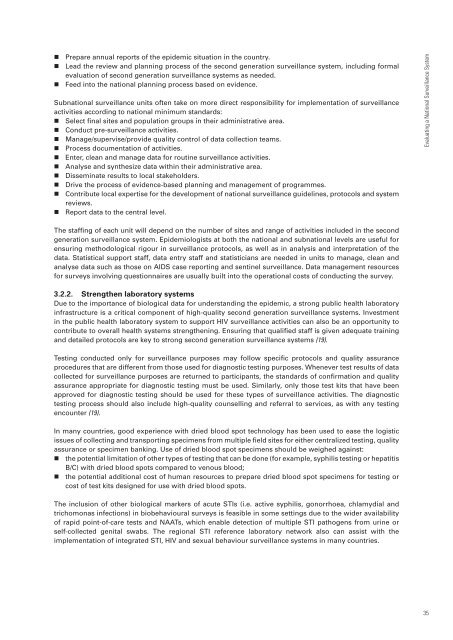Guidelines for second generation HIV surveillance - World Health ...
Guidelines for second generation HIV surveillance - World Health ...
Guidelines for second generation HIV surveillance - World Health ...
You also want an ePaper? Increase the reach of your titles
YUMPU automatically turns print PDFs into web optimized ePapers that Google loves.
• Prepare annual reports of the epidemic situation in the country.<br />
• Lead the review and planning process of the <strong>second</strong> <strong>generation</strong> <strong>surveillance</strong> system, including <strong>for</strong>mal<br />
evaluation of <strong>second</strong> <strong>generation</strong> <strong>surveillance</strong> systems as needed.<br />
• Feed into the national planning process based on evidence.<br />
Subnational <strong>surveillance</strong> units often take on more direct responsibility <strong>for</strong> implementation of <strong>surveillance</strong><br />
activities according to national minimum standards:<br />
• Select final sites and population groups in their administrative area.<br />
• Conduct pre-<strong>surveillance</strong> activities.<br />
• Manage/supervise/provide quality control of data collection teams.<br />
• Process documentation of activities.<br />
• Enter, clean and manage data <strong>for</strong> routine <strong>surveillance</strong> activities.<br />
• Analyse and synthesize data within their administrative area.<br />
• Disseminate results to local stakeholders.<br />
• Drive the process of evidence-based planning and management of programmes.<br />
• Contribute local expertise <strong>for</strong> the development of national <strong>surveillance</strong> guidelines, protocols and system<br />
reviews.<br />
• Report data to the central level.<br />
Evaluating a National Surveillance System<br />
The staffing of each unit will depend on the number of sites and range of activities included in the <strong>second</strong><br />
<strong>generation</strong> <strong>surveillance</strong> system. Epidemiologists at both the national and subnational levels are useful <strong>for</strong><br />
ensuring methodological rigour in <strong>surveillance</strong> protocols, as well as in analysis and interpretation of the<br />
data. Statistical support staff, data entry staff and statisticians are needed in units to manage, clean and<br />
analyse data such as those on AIDS case reporting and sentinel <strong>surveillance</strong>. Data management resources<br />
<strong>for</strong> surveys involving questionnaires are usually built into the operational costs of conducting the survey.<br />
3.2.2. Strengthen laboratory systems<br />
Due to the importance of biological data <strong>for</strong> understanding the epidemic, a strong public health laboratory<br />
infrastructure is a critical component of high-quality <strong>second</strong> <strong>generation</strong> <strong>surveillance</strong> systems. Investment<br />
in the public health laboratory system to support <strong>HIV</strong> <strong>surveillance</strong> activities can also be an opportunity to<br />
contribute to overall health systems strengthening. Ensuring that qualified staff is given adequate training<br />
and detailed protocols are key to strong <strong>second</strong> <strong>generation</strong> <strong>surveillance</strong> systems (19).<br />
Testing conducted only <strong>for</strong> <strong>surveillance</strong> purposes may follow specific protocols and quality assurance<br />
procedures that are different from those used <strong>for</strong> diagnostic testing purposes. Whenever test results of data<br />
collected <strong>for</strong> <strong>surveillance</strong> purposes are returned to participants, the standards of confirmation and quality<br />
assurance appropriate <strong>for</strong> diagnostic testing must be used. Similarly, only those test kits that have been<br />
approved <strong>for</strong> diagnostic testing should be used <strong>for</strong> these types of <strong>surveillance</strong> activities. The diagnostic<br />
testing process should also include high-quality counselling and referral to services, as with any testing<br />
encounter (19).<br />
In many countries, good experience with dried blood spot technology has been used to ease the logistic<br />
issues of collecting and transporting specimens from multiple field sites <strong>for</strong> either centralized testing, quality<br />
assurance or specimen banking. Use of dried blood spot specimens should be weighed against:<br />
• the potential limitation of other types of testing that can be done (<strong>for</strong> example, syphilis testing or hepatitis<br />
B/C) with dried blood spots compared to venous blood;<br />
• the potential additional cost of human resources to prepare dried blood spot specimens <strong>for</strong> testing or<br />
cost of test kits designed <strong>for</strong> use with dried blood spots.<br />
The inclusion of other biological markers of acute STIs (i.e. active syphilis, gonorrhoea, chlamydial and<br />
trichomonas infections) in biobehavioural surveys is feasible in some settings due to the wider availability<br />
of rapid point-of-care tests and NAATs, which enable detection of multiple STI pathogens from urine or<br />
self-collected genital swabs. The regional STI reference laboratory network also can assist with the<br />
implementation of integrated STI, <strong>HIV</strong> and sexual behaviour <strong>surveillance</strong> systems in many countries.<br />
35
















